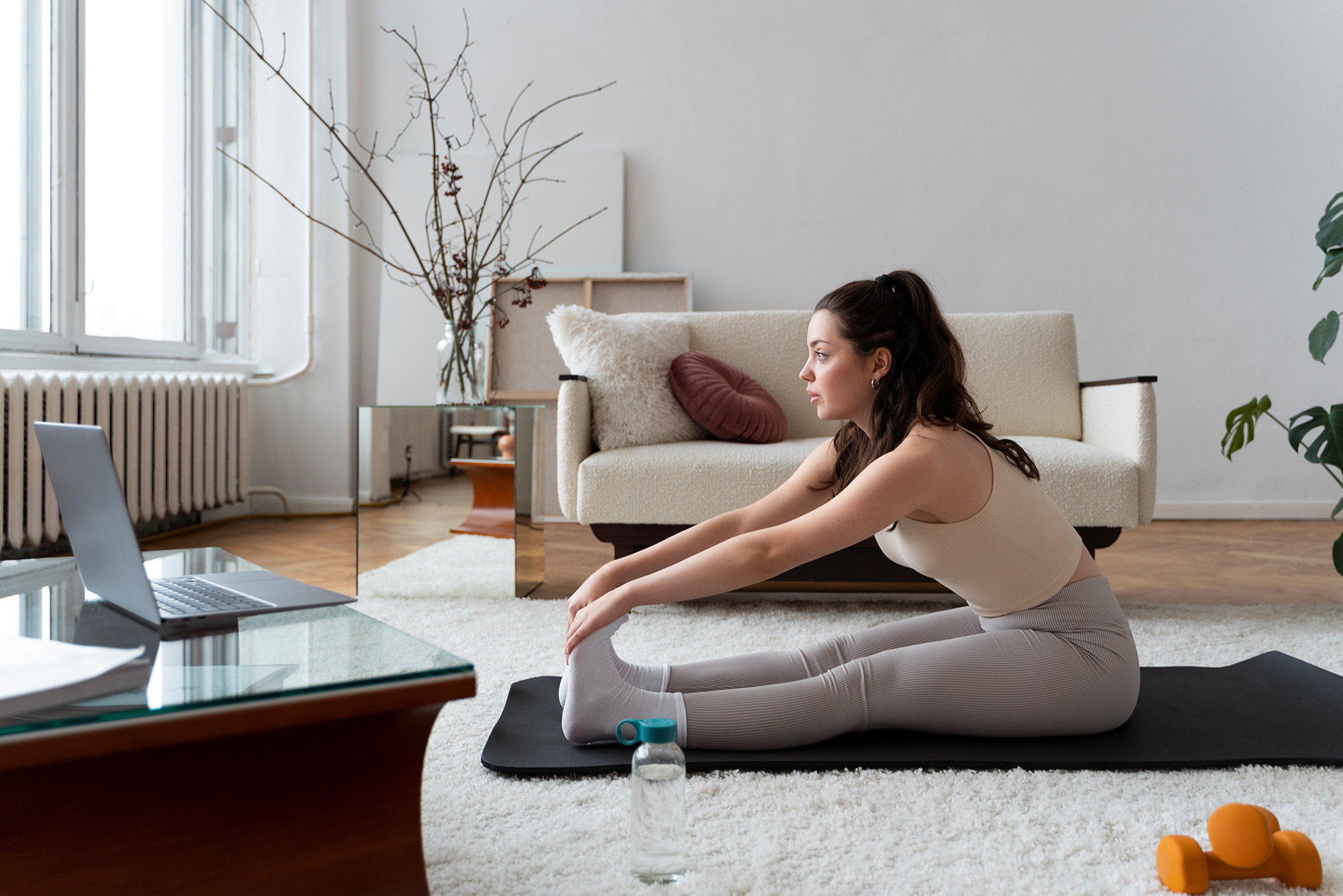When they think of the word “home,” people typically associate it with feelings of comfort, new beginnings, family, and generational milestones. With all the promise that a house’s four walls provide, home can also harbor emotional pain.
The source of the discomfort may have nothing to do with the people who live in a house, but the location, layout, design, materials used, interior appointments, and the surrounding environment. All these things can play a role in hurting your mental health.
You have a say in your home environment
No matter what goes on in your day, the idea of going home brings a sense of relief. The rooms may be in disarray, the kids are likely out of sorts, but you know the moment you walk in and make a beeline to your bedroom, the bra comes off, the hair goes up, and the outside world goes away.
But what if you could take your home from casual landing pad to an energy hub? You can, and your health and wellbeing depend on it.
There’s a psychology to where you live
One of the spoken (and sometimes unspoken) rules of employment is to keep your personal life out of work. Easier said than done, especially if you work from home. However, if you do commute to the office for a 9 to 5 (more like 7 to 6) commitment—side hustle not included—personal life is work life, and here’s why.
People are impacted by the environment, yet our home can dictate how we respond to the world and its people, and how we perform at our jobs.
Environmental psychology is the study of how our surroundings affect people and how people affect our surroundings. This two-way process includes the structures we live in whether a house, townhome, condo, loft, or boat docked on the lake. Each can support better health or compromise mental stability, and the reasons behind it are kinda cool.

For example, if you grew up in the same house for 15 years and then your parents sold it, you’d be sad about it. There are personal memories wrapped up in that place and you’ve built an emotional attachment to it and those memories. This is how environmental psychology impacts wellness.
The structure of a building, its design and shape, can also illustrate how the environment influences how you feel. Known as architectural psychology, this science looks at how home design affects human experiences and behaviors. For instance, if you’ve gone house hunting in the past and checked out homes built in the early 1970s, you likely noticed how low the ceilings are. If you’re six feet tall, that could be a problem. And for people who tend to feel claustrophobic in smaller spaces, those older homes won’t work.
But there can be issues with the opposite scenario, too. A good friend of mine has trouble in airports with high ceilings. If she wants to travel, and the airport terminal (from entry to gate) has a high ceiling, which is common with newer airports that have multiple floors for check-in, TSA security and gates, business offices, and parking, her body stiffens, her heart races and she breaks into a cold sweat. I still don’t know to this day where that came from, but it’s an environmental phobia.
It turns out that the floor plans we live with and how we organize our room settings (and the amount of clutter) can help or hinder our mental abilities as well—what the American Psychological Association (APA) calls organizational psychology. It’s wild how life-changing a family home can be.
Where you live affects the family’s wellbeing
Moving into a newly built or resale home is an exciting time, and can turn on different emotions: happiness, sadness, anxiousness, and a little bit of all-over-the-place as you bounce from room to room unpacking.
Down the road, you might feel unsure about your decision. A job can change, financial stability can shift, your child can be injured while playing on the soccer field—and what was once a doable expense is now maxing out your “affordability factor.”
Increased stress starts to affect your sleep, which impacts overall physical and mental health. The quality of a home can be measured by the building materials used and their condition. These are characteristics that are often overlooked by a homebuyer but can be detrimental to family wellness.
In addition to causing physical injuries, low quality housing can harm your child’s early development and psychological health. Hidden environmental hazards like lead-based paint can cause irreversible issues to the nervous system. Low-level exposure in kids can cause behavioral problems, like attention-deficit/hyperactivity disorder (ADHD), too.

In addition to the stress, anxiety, depression, emotional, and behavioral problems that low-quality housing can play a part of, it can also hurt your child’s ability to perform in school. No amount of extra tutoring or counseling can change how unsafe housing materials affect children.
You might be surprised to know there are about 45 million families across America’s 50 states that live in unhealthy housing. Some of the issues include a leaking roof, not enough insulation, broken windows, non-working appliances, poor ventilation (the air you breathe), unwanted pests (let your imagination run with it, “Yuck,”) not enough heat, or hot water, or electricity.
There are ways to minimize the risks of being at home. Here are some points to watch for, and suggestions to consider when doing repairs, remodeling, or buying your next home.
Clean indoor air helps heal the mind and body
Many people don’t realize that the air we breathe impacts our brain and mental health. The air pollution most talked about is airborne dust, also known as “particulate matter,” in the air outdoors and in your home.
Airborne dust finds its way inside through open doors, windows, cracks, and holes in buildings. Everyday household activities increase exposure to harmful air, through cooking on gas stoves and the chemicals used in cleaning products. Because humans spend 90 percent of their time indoors, the safety of being in your home is everything.
Ongoing exposure to air pollution is also linked to neurological conditions and increased risk for dementia, Alzheimer’s disease, Parkinson’s disease, and autism.
Children can lose their ability to remember things, reducing their math and reading comprehension, and test scores. Harmful air raises the risk of developing mental health issues, in children and teenagers.
All this information may drive you to search for a place with clean air and unspoiled natural resources, but life on a deserted island in the middle of nowhere like you’re on an episode of Survivor is probably not in the cards for you. But there are steps you can take to reduce toxic exposure in your house. By conducting regular maintenance and being sure you’re using the best products available, you can make minor changes that make a big difference.

1. Do a physical check of the outside of your home, the doors windows, stucco or siding, and roof to make sure the building is “airtight.”
2. Once a year, check that your ventilation system is functioning well, and contact an HVAC professional for a system tune-up before the summer and winter seasons.
3. Change air filters monthly, and upgrade them to a MERV13 rating or better.
4. If allergies put a damper on family fun, consider using portable air purifiers in rooms that get the most use and, when possible, replace carpet with hard-surface flooring.
5. Choose a Woodside Homes community. Many of our homes are Zero Energy Ready, providing superior indoor air quality, controlling mold and moisture, and keeping pests out. That’s healthier for you, your home, and our home planet, too.
Getting a better handle on what you can control in the home will do more than improve the family’s health—it’ll inspire you to do more.
Color and shape rule your world
Freshening up your interior décor gives you a chance to make a statement about who you are, and lifts your spirits. Pick a room in your home, any room, and give it a once over. Notice the color schemes, what stands out in furnishings, wall art or figurines, and the lighting. These are the elements that can help lift your mood and help you think more clearly.
Understanding color psychology
People look at color as a representation of how they feel. Black can indicate dark emotions or mystery (aside from giving the illusion of a slimmer physique). Color is also used to tell a story about a business, like a med spa or pediatrician’s office.
While you’re waiting for a facial, notice the tones of the reception area. If that spa did their homework, you’ll be surrounded in ivory or white, light neutral tones and blueish hues, promoting a Zenlike experience.
When you’re waiting patiently-not-so-patiently in the children’s doctor’s office for their well-check appointment, you may notice it’s dotted with bursts of bright colors—like orange and yellow, which promote curiosity, warmth, and happiness. Putting thought into the color design is another way of saying your child matters.
Make it bigger without increasing the size
You may not live in your forever home right now but that doesn’t mean you can’t make the most of it. For rooms lacking in size, use lighter furniture and wall colors to create the illusion of an airy space. Bright and off-white shades, and touches of tan or taupe can take in natural and artificial light and bounce it around the room well.
Be eco-centric
With more time spent indoors, finding ways to bring the benefits of the outdoors in will improve your personal outlook.
The essence of nature lives in the color green. Home therapist Anita Yokota says there are studies linking “the color green and plant life to improved memory, concentration, and focus.”
If you’re having trouble getting motivated, add a muted mint green accent wall in your home office with a bamboo plant on the corner of your desk and you’ve got an eco-centric workspace.
With these ideas, you can set the tone of your household for the better.
Let your light shine

Binge-watching your favorite Disney flick (for the 10th time) with the kids looks better on the screen when you’re shuttered in with the blinds closed and drapes drawn. But, while sitting in the dark enhances your movie experience, it doesn’t do any favors for your health.
Maybe you’ve heard of seasonal depression. It’s a condition that can affect people who live in parts of Alaska or Washington during the winter, when total hours of sunlight diminish from inclement weather or the sun barely peeking above the horizon.
Light from sunshine and inside sources can provide therapy throughout the year. A room filled with natural light instantly creates a sense of balance and calm, reducing feelings of depression and anxiety. For indoor spaces with low natural light, add enough lighting to support the typical activities of that room. If it’s a multipurpose area, add a few recessed ceiling lights with dimmer switches, so you can adjust the brightness.
Clutter does not belong
Clutter and messiness can make a room feel smaller than it really is. And too much stuff laying around can increase stress and make us feel unhappy about life. So, get cleaning!
Find better flow by following feng-shui
A home holds its own energy—and people attract and deflect energy. You know the saying about being able to cut the tension with a knife? It’s a saying for a reason.
Mae Kwan, architect and wellness consultant , advocates using feng shui for the home, because it allows the natural flow of energy to create balance and harmony. She advises moving away from décor trends to choose furnishings that truly represent who you are. The result is household energy that’s in sync with the people who live there.
Once the right energy is established, then focus on space blocking. Where you place furniture can open energy flow or inhibit it. If the headboard of your bed blocks the window, or the coffee table is in direct line of a patio door forcing you to move around it, the furniture layout goes against feng shui. According to Kwan, this obstructs energy flow and keeps it stagnant, and, in turn, the family can feel stuck.
Other feng shui principles include clearing the clutter, keeping your home clean, and for 2024, placing personal earth elements like plants, or fire elements like red or yellow candles, in the north end of your home to bring in wealth and good luck. Who knows? They could be on sale at Target.
Green communities keep the kids happy
After you make the home repairs, upgrade air systems and appliances, pick up the clutter (and keep it clean), move furniture to increase energy flow, maneuver more light into the home, soothe with color and plant life, it’s time to add some scenery.
For moms expecting a first child or if your home is filled with toddlers and youngsters up to age five, a recent study by the University of North Carolina, Chapel Hill, uncovered a link between preschoolers with emotional problems and time spent in green spaces near their homes.
If you live in a community with a neighborhood park or have a back yard with many trees and plants, you can boost your young child’s mental health just by spending time there. Children who live near green spaces from birth are less likely to have anxiety or depression from ages two to five.
A daily dose of green time improves kids’ brain activity while they experience the good feels from exploring new places and discovering the beauty of nature. So, get the stroller out of the garage, park it near the front door and get rid of the excuse that getting outside is a hassle.
Be intentional about going green each day
· Schedule visits to parks, trails, or other natural areas into your family’s routine.
· Set up nature scavenger hunts and search for whatever’s natural to the surroundings, like stones, flowers, squirrels, or lizards. (But watch for poisonous plants and critters that sting.)
· If the weather permits, schedule green time before bathtime. If you aren’t comfortable with the kids rolling around in the dirt, it’s easier to accept the mess knowing that the cleanup comes right after.
· Let children know how important it is to preserve and support green spaces. Get involved in community conservation efforts or start a neighborhood garden in your own backyard. It’s a way to get more social and invite others into your home.
If you’re considering a do-over, a new Woodside home gives buyers like you room to grow, with thoughtfully designed interiors and flexible spaces designed to evolve with the needs of your family—not to mention all the amenities a family wants. Plus, you can personalize your new home with features designed to prioritize your wellbeing.
How to strengthen mental health where you live
Your home is your sanctuary. To help you live your best life, Woodside Homes builds safe, healthy homes combining high-quality materials, energy-efficient features, and family-friendly floor plans, in communities where you can flourish.
Upgrade your life with an upgraded home that complements your good taste. And the benefits of a new Woodside home extend beyond your new address—they live in the neighborhoods and wonderful people you’re about to meet. To get started, come tour a Woodside Homes community. Schedule an onsite visit or virtual appointment with one of our sales consultants.








